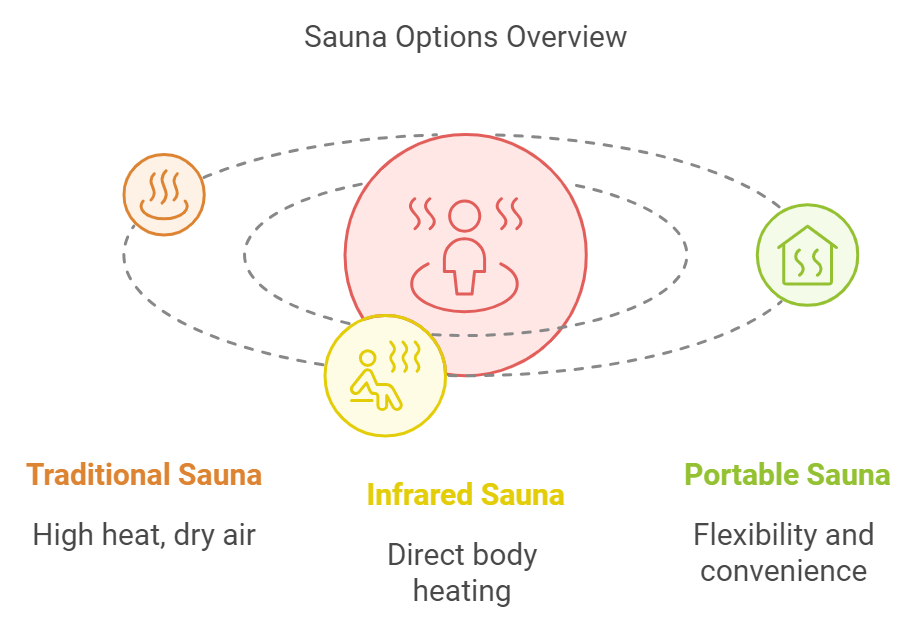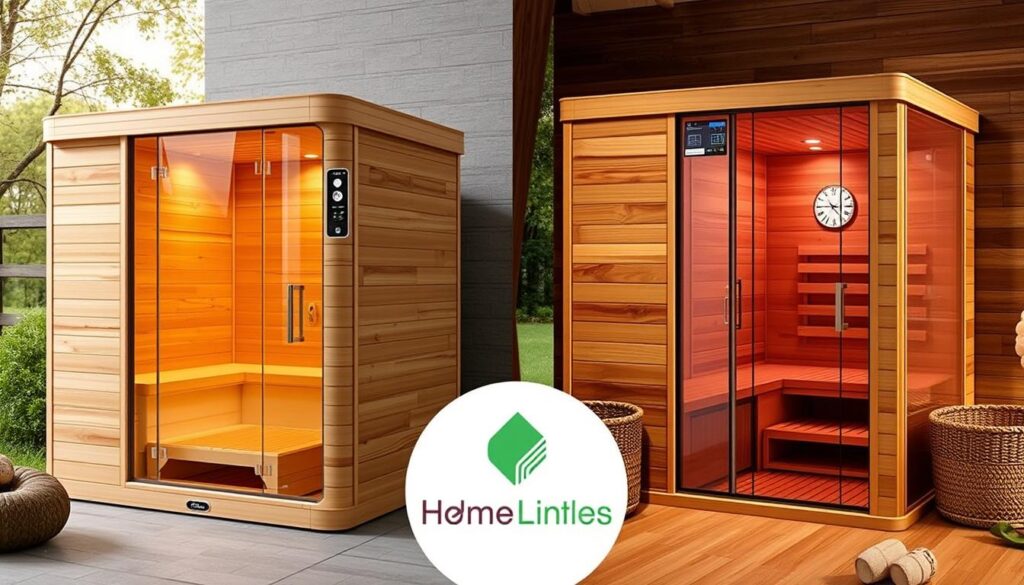Ever thought about which sauna could change your wellness game? Choosing between a portable home sauna and an infrared sauna might seem tough. But, it’s a choice that could really boost your health journey. Let’s explore the world of saunas and find the best fit for you.
Saunas have evolved a lot since Finland’s ancient times. Now, we can enjoy them at home with modern features. Whether you prefer the classic warmth of a home sauna or the high-tech feel of an infrared sauna, each has its own benefits.
Portable saunas are loved for their ease and flexibility. They let you enjoy sauna benefits without taking up too much space. Infrared saunas, on the other hand, use advanced tech to warm your body directly, offering a unique experience.
When picking between these options, think about space, cost, and health benefits. Infrared saunas are often cheaper, with some under $400. They heat up to 105-140°F, making them comfy for longer stays. Traditional saunas, though pricier, offer intense heat that many find refreshing.
Both saunas offer great health benefits. They can improve circulation, sleep, skin, and stress relief. Some people even find them helpful for anxiety. The secret to enjoying these benefits is regular use, with experts suggesting 2-4 sessions a week.
Table of Contents
Key Takeaways
- Portable saunas offer flexibility and space-saving benefits
- Infrared saunas use modern technology for direct body heating
- Traditional saunas provide intense heat for a classic sauna experience
- Both types offer health benefits like improved circulation and relaxation
- Consistent use is key to experiencing the full range of sauna benefits
- Consider space, budget, and personal preferences when choosing a sauna
Understanding Sauna Types: Home Sauna and Infrared Sauna
Saunas are great for health, offering relaxation and better heart health. Let’s look at the different saunas you can use at home.
Traditional Home Saunas
Traditional saunas warm the air with wood, electric, or gas heaters. They get very hot, between 150°F to 195°F. This makes a dry, hot space that helps you sweat and relax.
Infrared Saunas
Infrared saunas use light to heat your body directly. They work at lower temperatures, 120-150°F. They’re also energy-saving, using less power than traditional saunas.
Portable Sauna Options
If you have little space or like to move things around, portable saunas are perfect. You can find towable saunas, sauna blankets, and tent saunas. They let you enjoy sauna benefits without needing a permanent setup.

| Sauna Type | Temperature Range | Key Feature |
|---|---|---|
| Traditional | 150°F – 195°F | High heat, dry air |
| Infrared | 120°F – 150°F | Direct body heating |
| Portable | Varies | Flexibility and convenience |
Each sauna type has its own benefits. Your choice depends on what you like, how much space you have, and what health benefits you want. Whether it’s a traditional sauna, infrared, or portable, using a sauna regularly can make you feel better and more relaxed.
The History and Evolution of Saunas
The Finnish sauna culture goes back to 7000 BC. Early Finns dug pit saunas into embankments. This started a tradition that lasted for thousands of years. These early saunas were for both physical and spiritual cleansing.
Over time, saunas evolved. Wooden cabins with fireplaces and stones replaced the old pit structures. This change showed how important saunas became in Finnish life. Soon, saunas became popular around the world, changing how people bathed together.
The 20th century saw big changes in sauna technology. Electric sauna stoves came in around 1950. This made saunas easier to use and more popular everywhere.
In 1965, Japan introduced the first far infrared sauna. This new technology used infrared light to warm the body. It offered special health benefits and quickly became popular globally.
| Year | Milestone |
|---|---|
| 7000 BC | First pit saunas in Finland |
| 1950 | Introduction of electric sauna stoves |
| 1965 | Invention of far infrared sauna in Japan |
| 1979 | First broad spectrum infrared saunas in the USA |
Today, saunas mix old traditions with new tech. You can find everything from Finnish-style steam saunas to modern infrared cabins. This long history of sauna culture keeps shaping how we think about wellness, offering relaxation and health to millions.
Health Benefits of Sauna Use
Sauna use has many health benefits that can improve your overall well-being. It can help your heart function better and reduce stress. Regular sauna sessions can positively affect many health areas.
Cardiovascular Health
Sauna sessions can be like moderate exercise for your heart. Studies show they may lower blood pressure and help heart failure symptoms. The heat makes your heart rate go up, like walking at a moderate pace.
Detoxification
Detox claims are debated, but saunas help with sweating. This can remove toxins. Research on harmful substance exposure showed benefits, but more study is needed for detox benefits.
Stress Relief and Relaxation
Saunas are a great place for stress relief. The warm environment can reduce depression, anxiety, and stress. It’s like a meditation session in warm temperatures, promoting relaxation and mental well-being.
Skin Health
Sauna use can improve your skin health. It increases blood flow and promotes sweating. This helps cleanse pores and gives your skin a healthy glow.
| Sauna Type | Temperature Range | Key Benefits |
|---|---|---|
| Traditional Sauna | 150°F – 195°F (65.55°C – 90.55°C) | Intense sweating, muscle relaxation |
| Infrared Sauna | 110°F – 135°F (43.33°C – 57.22°C) | Deep tissue penetration, gentler heat |

To get the most benefits from saunas, limit sessions to under 30 minutes, 3-4 times a week. Stay hydrated and avoid alcohol. Always talk to a healthcare provider before starting sauna therapy for specific conditions.
Portable Home Saunas: Convenience and Flexibility
Portable home saunas bring the benefits of sauna flexibility right to your doorstep. These mobile wellness solutions cater to various needs and spaces, making sauna therapy accessible to everyone.
From lightweight blankets to compact tents, portable saunas offer a range of options. The Sun Home Saunas Infrared Sauna Blanket, priced under $500, proves that mobile sauna experiences needn’t break the bank. It heats up to 167°F and features EMF shielding for added safety.
For those seeking cutting-edge technology, the Sunlighten Solo Portable Sauna stands out. With near-zero EMF emissions and nine heaters, it offers a premium sauna experience in a compact package. Though pricier at $2,699, it’s still more affordable than built-in alternatives.
Portable wellness options cater to different preferences:
- Blanket-style saunas for easy storage
- Dome and pad combos for targeted heat therapy
- Tent structures for a more traditional sauna feel
These mobile sauna solutions heat up quickly. The SereneLife SLISAU35BK Steam Sauna, for instance, is ready in just 15 minutes. With temperatures ranging from 130°F to 200°F, there’s a portable sauna to suit every need.
| Portable Sauna Type | Weight | Max Temperature | Key Feature |
|---|---|---|---|
| Infrared Blanket | Under 15 lbs | 167°F | EMF shielding |
| Solo Portable | Varies | Up to 200°F | 9 heaters |
| Steam Sauna | Under 15 lbs | 140°F | Quick heat-up |
Infrared Saunas: Modern Technology for Wellness
Infrared saunas bring cutting-edge wellness to your home. They use infrared technology to heat your body directly. This makes for a comfortable experience at lower temperatures. Let’s explore the different types of infrared saunas and their unique benefits.
Near-Infrared vs. Far-Infrared
Near-infrared and far-infrared saunas offer distinct advantages. Near-infrared penetrates deep into the skin, promoting wound healing and skin rejuvenation. Far-infrared, on the other hand, is absorbed more superficially and excels in detoxification and cardiovascular health. Some saunas even include mid-infrared, which can help ease muscle discomfort.
| Infrared Type | Benefits |
|---|---|
| Near-Infrared | Wound healing, pain relief, skin rejuvenation |
| Mid-Infrared | Muscle discomfort relief |
| Far-Infrared | Detoxification, improved cardiovascular health, weight loss |
Full-Spectrum Infrared Saunas
Full-spectrum infrared saunas combine near, mid, and far-infrared wavelengths for a comprehensive wellness experience. These saunas offer customizable sessions tailored to your specific health goals. For example, the Health Mate Enrich Infrared Sauna provides all three infrared types, along with chromotherapy lighting and a Bluetooth sound system.
When choosing an infrared sauna, consider factors like EMF emissions, heater type, and additional features. Carbon heaters distribute heat evenly, while ceramic heaters warm up quickly. The Dynamic Sauna Barcelona Edition, for instance, uses low EMF far-infrared carbon heating panels and is made from natural hemlock wood.
“Infrared saunas have been life-changing for me. The relaxation and tension release I experience is unparalleled,” shares Tiphany Adams, a fitness coach who uses red light therapy in her wellness routine.
With their efficient heating, deep tissue penetration, and customizable experiences, infrared saunas represent the forefront of home wellness technology.
Comparing Costs: Portable vs. Infrared Saunas
Portable saunas are often cheaper than other types. A comparison shows big price gaps between traditional, infrared, and portable saunas. Traditional saunas cost between $5,000 and $12,000. Infrared saunas are priced from $3,000 to $8,000. Portable options like blankets and tents are under $400.
Operating costs also vary. Infrared saunas use less energy than traditional ones. This can mean lower bills over time. It’s a key factor when thinking about the cost of a sauna.
| Sauna Type | Price Range | Energy Efficiency |
|---|---|---|
| Traditional | $5,000 – $12,000 | Lower |
| Infrared | $3,000 – $8,000 | Higher |
| Portable | Under $400 | Highest |
Portable saunas save money in more ways than one. They are small and easy to set up anywhere. This is great for those living in small spaces.
They are also light, making it easy to take them anywhere. This means you can enjoy sauna benefits at home, work, or on the go. It’s a smart way to get the most out of your investment.
Space Considerations for Your Home Sauna
When planning your home sauna space, size is key. Traditional saunas take up more room, but infrared saunas are more compact. Let’s look at the space needs for each type.
Room Requirements for Traditional Saunas
Traditional saunas need a lot of space. They usually range from 4×4 feet to 8×12 feet. They should be seven feet tall to keep heat in.
For comfort, make sure there’s at least two feet per person. Six feet is even better for reclining.
Compact Solutions for Infrared Saunas
Infrared saunas are great for small spaces. They heat your body directly, so you can stay in longer. These compact saunas are becoming more popular for home use.
| Sauna Type | Minimum Size | Ideal Location | Power Requirement |
|---|---|---|---|
| Traditional | 4×4 feet | Basement or Outdoors | 240V |
| Infrared | 3×3 feet | Indoors (any room) | 120V |
When installing a sauna, think about ventilation and electrical needs. Basements are a top choice, with 45-50% of users picking them. Outdoor setups need protection from the weather. Proper planning makes your sauna a relaxing spot in your home.
Energy Efficiency and Operating Costs
It’s key to know how much energy a sauna uses to run well. Saunas vary in energy needs, affecting your bills and the environment.
Traditional saunas use more electricity than infrared ones. A 75-minute session in a traditional sauna uses about 225 kWh each month. In contrast, infrared saunas use around 120 kWh monthly for 40-minute sessions each day. This is because infrared saunas heat directly and warm up faster.
Power needs also differ a lot. Infrared saunas need no more than 1.6 kW, while traditional ones might need 3.0-4.0 kW. This difference impacts both energy use and operating costs of home saunas.
| Sauna Type | Monthly Energy Use (kWh) | Estimated Monthly Cost |
|---|---|---|
| Traditional | 225 | $27.00 |
| Infrared | 120 | $14.40 |
Things like size, insulation, heating time, and how often you use it affect energy use. To figure out your sauna’s electricity use, multiply wattage by time in hours. Keep in mind, the biggest cost of owning a sauna is usually the initial buy and setup.
Maintenance and Longevity of Different Sauna Types
Keeping your sauna in good shape is key to its long life. Each type of sauna needs different care to work well and last long.
Traditional saunas need regular wood care and heater checks. Their heaters can last 20-30 years with the right care. Infrared saunas are easy to maintain, needing only cleaning and checking the electrical parts. Their heaters can last up to 50 years, with ceramic and carbon heaters offering efficient heat and similar long life.

Portable saunas, like blankets and tents, might not last as long because they move a lot. Indoor saunas usually last longer than outdoor ones because they’re protected from the weather. Keeping outdoor saunas in a safe place can help prevent wood damage and extend their life.
Good sauna care means cleaning it after each use and using distilled water in steam models to avoid mineral buildup. This care can make a sauna last 30-50 years, especially with high-quality units.
| Sauna Type | Maintenance Level | Average Lifespan |
|---|---|---|
| Traditional | High | 20-30 years |
| Infrared (Ceramic) | Low | Up to 50 years |
| Infrared (Carbon) | Low | Around 50 years |
| Portable | Medium | 5-10 years |
Personalizing Your Sauna Experience
Sauna customization lets you make your own perfect relaxation spot. You can choose between traditional or infrared saunas. There are many ways to make your personalized sauna experience just right for you.
Customization Options for Home Saunas
Home saunas offer many choices for customization. You can pick the size, wood type, and heating method that fits your needs. Cedar and hemlock woods are favorites because they last long and smell nice.
For heat, you can go with traditional rock and heater systems or modern infrared panels.
Adjustable Features in Infrared Saunas
Infrared saunas have advanced features for customization. They often have adjustable temperature settings and chromotherapy lighting. Some even have built-in audio systems for a deeper experience.
These features help you set the mood for your sauna sessions just the way you like it.
| Customization Option | Description | Price |
|---|---|---|
| Red Light Therapy Tower | Enhances skin health and cellular regeneration | $1599 (Save $400) |
| HALOONE® Halotherapy | Improves respiratory health with salt therapy | $1199 (Save $400) |
| Aroma One® Essential Oil Diffuser | Adds aromatherapy benefits to your sauna session | $88 (Save $36) |
| Vibration Resonance Therapy | Promotes relaxation and stress relief | $550 (Save $200) |
Think about what you like and what you want to achieve with your sauna. With these options, you can make a sauna that’s truly yours and meets your needs.
Conclusion
Choosing the right sauna is key for your wellness journey. Portable home saunas are great for those with little space or a small budget. They’re easy to set up and move, perfect for renters or travelers.
Infrared saunas, on the other hand, use modern tech. They work at lower temperatures than traditional saunas, making them comfy for those who can’t handle high heat. They also offer deeper heat, which can help release toxins and improve skin and sports recovery.
Think about your space, budget, and health goals when picking a sauna. Both portable and infrared saunas can enhance your wellness routine. The best sauna is one you’ll use often. Whether it’s a portable sauna’s ease or an infrared sauna’s advanced features, you’re on your way to better health and relaxation.







